Social-Political Issues
 |
 |
 |
 |
 |
 |
 |
Stalinism in Brazil - I
An Overview of Its Early Terrorist Character
What does Brazil have in common with Cuba, China, Vietnam and North Korea? The answer can be summed up in one word: Stalinism.
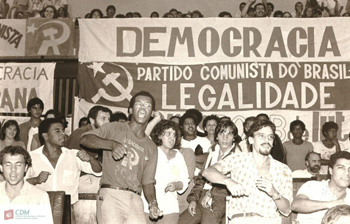 Brazil, Cuba, China, Vietnam and North Korea are the five fingers of the hand called Stalinism.
Brazil, Cuba, China, Vietnam and North Korea are the five fingers of the hand called Stalinism.
Brazilian Communism is one of the cruelest and most efficient representatives of this current, being most faithful to Stalinist principles.
It is not difficult to demonstrate this fact. This is what I will try to do in this brief study, which I will divide into parts for the sake of clarity. In this first part I will show how the Soviet model was followed in Brazil.
Terrorist character of Russian Communism
Transposing the ideas and events in Russia at the beginning of the 19th century to Brazil in the first half of the 20th century, we see that the first important link between the two situations is religion.
Although religion was denied and combated right up to its destruction by Communism, through Marxist-Leninist dialectics it was also used as an instrument of conquest.
Stalin, the son of a devout mother, attended religious schools and a seminary. There he became involved with the Marxist "intelligentsia" and joined Communism.
Expelled from the seminary as a dangerous person, he followed Bakunin's primer and adopted Lenin as master. He was made one of the directors of the newly founded Social Democrat Workers Party, which operated illegally.
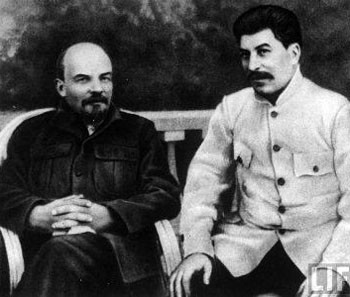 Stalin and Lenin shared a deep and fierce hatred for the Czar, manifested by the revolutionary street fights, mass demonstrations and distribution of ideological pamphlets.
Huge strikes were promoted, causing the proprietors of large factories, such as the Rothschilds and the Mantachiofs, to shake. They preached the radical dictatorship of the proletariat, popular revolts, riots, strikes, and terror.
Stalin and Lenin shared a deep and fierce hatred for the Czar, manifested by the revolutionary street fights, mass demonstrations and distribution of ideological pamphlets.
Huge strikes were promoted, causing the proprietors of large factories, such as the Rothschilds and the Mantachiofs, to shake. They preached the radical dictatorship of the proletariat, popular revolts, riots, strikes, and terror.
To maintain these efforts they needed money. So, they started what they called "expropriations," which was looting churches and government coffers.
Invasions, pillages, assaults and robberies were also frequently made, as were counterfeit money machines and calculated marriages of young communists with elderly, wealthy widows. Lenin and Stalin planned an assault on the state-owned money carrier on the road that the bank's stagecoach took between Petersburg and Tiflis. Comrade Ter Petrossian was in charge of getting the weapons, ammunition and dynamite, which was hidden in the house of Stalin.
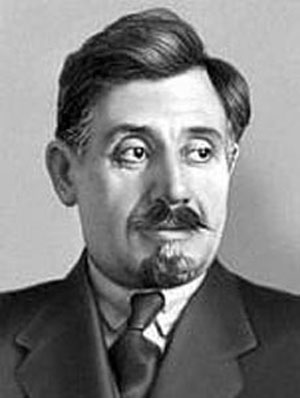 On June 13, 1907, two coaches loaded with money escorted by Cossacks on horseback, stopped in the square in front of the bank. The terrorist robbers Lenin and Stalin pulled the fuses of their grenades and threw them at the carriage, causing the horses to bolt and flee, still hauling the coaches with their bags of money.
On June 13, 1907, two coaches loaded with money escorted by Cossacks on horseback, stopped in the square in front of the bank. The terrorist robbers Lenin and Stalin pulled the fuses of their grenades and threw them at the carriage, causing the horses to bolt and flee, still hauling the coaches with their bags of money.
The group fired shots on all sides to chase away passers-by. One of them threw another grenade between the legs of the running horse and it fell to the ground, stopping the stagecoach. At least 50 innocent people died: men, women and children.
The communist robbers took the money bags and hid them in Stalin's house. None of the perpetrators were found or arrested, revealing some complicity of the police with the criminals. Lenin designated the money for the purposes of the Party.
In an article "The Heroes of the Revolution," published in 1925, Ter Pretossian provided details of his central role in this criminal plot. The organizer behind this and other "expropriations" was Stalin, a fact explicitly confirmed by the magazine Sotsialistitcheski Viestnik (Socialist Messenger).
Communist terrorism in Brazil
During this time Brazil was undergoing a phase of political and institutional instability, since the Monarchy had just been overthrown and the first Republican government was hesitant, trying to find its way.
The Brazilian presidents of that period (1898-1918) were, successively, Campos Salles, Rodrigues Alves, Affonso Pena, Nilo Peçanha, the military commander Hermes da Fonseca, Wenceslau Brás and Rodrigues Alves. Each in his own way was trying to organize the Republican country.
An expressive example of Stalinism can be seen in the Communist uprising of 1935, led by Luiz Carlos Prestes, which I mention here only in passing since I will dedicate more time to it in my next installment.
After Prestes’ communist uprising in 1935, the Stalinist terror took about 30 more years to manifest itself again in Brazil with the start of the Military Regime (1964 to 1985). I believe that regime was needed to stop Brazilian rulers from taking steps toward communist countries.
For example, Jânio Quadros had shown sympathy for this ideology when he decorated Fidel Castro and Che Guevara, and president João Goulart had declared himself clearly in favor of Chinese and Russian Communism.
It was only after President João Goulart was deposed by a military revolution in 1964 that Stalinist terrorism raised its head in Brazil. Two of the leading exponents of this Stalinist-Leninist were Carlos Marighella and Carlos Lamarca. Let me say a word about them.
In his Guerrilla Handbook, Marighella used Stalin's same expression – "expropriation" – to refer to terrorist assaults on public and private property.
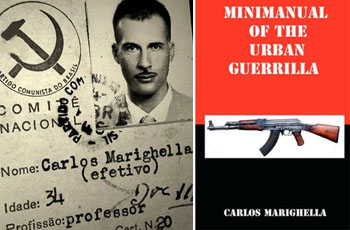
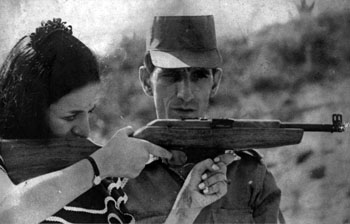 He called for "the expropriation of government resources and those belonging to the great capitalists, landowners and imperialists, with small expropriations to be used for the maintenance of individual urban guerrillas and large expropriations for the support of the guerrilla movement."
He called for "the expropriation of government resources and those belonging to the great capitalists, landowners and imperialists, with small expropriations to be used for the maintenance of individual urban guerrillas and large expropriations for the support of the guerrilla movement."
Carlos Lamarca deserted from the Brazilian Army in 1964, and in 1968 he became a shooting instructor for the employees of the Banco Brasileiro de Descontos (BRADESCO) so they could defend themselves against armed robberies. He took advantage of that position to insert guerrilla insiders into the bank.
Lamarca was recruited for the revolutionary armed struggle by the Popular Revolutionary Vanguard (PRV) and became one of its leaders.
On January 25, 1969, accompanied by a sergeant, a corporal and a soldier, he robbed the barracks of Regiment Raposo Tavares (IV RI) in Quitaúna, State of São Paulo, carrying off 69 rifles, 10 machine guns and three bazookas.
In July he commanded one of the largest robberies ever carried out in Brazil: the theft of the safe box of the former governor of Sao Paulo, Adhemar de Barros, which weighed about 450 pounds and contained $2.5 million in cash.
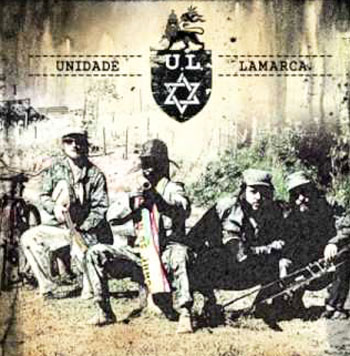 In 1970, Lamarca started a guerrilla base in Ribeira Valley in the State of São Paulo. In that same year he wrote a manifesto that was mailed to a large number of Army officers. In that document he made his "Marxist-Leninist" profession of faith and called on the military to form an "army of the people" that would fight for "the factories to be run by the workers themselves."
In 1970, Lamarca started a guerrilla base in Ribeira Valley in the State of São Paulo. In that same year he wrote a manifesto that was mailed to a large number of Army officers. In that document he made his "Marxist-Leninist" profession of faith and called on the military to form an "army of the people" that would fight for "the factories to be run by the workers themselves."
In Brazil, the number of violent acts carried out by urban guerrillas - including killings, explosions, stealing weapons, ammunition and explosives, bank robberies, kidnappings of foreign diplomats (to trade for the release of terrorist prisoners) etc. - leaves no doubt about the communist intent of the revolutionary perpetrators. Around 120 persons were killed by leftist guerrillas in that period.
Given the ideal that they strove for as well as the methods they used, it can be concluded that in this phase, the communists in Brazil adopted a Stalinist Communism.
Continued


Although claiming democracy and legality Brazil's Communist Party is a constant source of violence
Brazilian Communism is one of the cruelest and most efficient representatives of this current, being most faithful to Stalinist principles.
It is not difficult to demonstrate this fact. This is what I will try to do in this brief study, which I will divide into parts for the sake of clarity. In this first part I will show how the Soviet model was followed in Brazil.
Terrorist character of Russian Communism
Transposing the ideas and events in Russia at the beginning of the 19th century to Brazil in the first half of the 20th century, we see that the first important link between the two situations is religion.
Although religion was denied and combated right up to its destruction by Communism, through Marxist-Leninist dialectics it was also used as an instrument of conquest.
Stalin, the son of a devout mother, attended religious schools and a seminary. There he became involved with the Marxist "intelligentsia" and joined Communism.
Expelled from the seminary as a dangerous person, he followed Bakunin's primer and adopted Lenin as master. He was made one of the directors of the newly founded Social Democrat Workers Party, which operated illegally.

Stalin & Lenin destroyed the monarchic past of Russia
To maintain these efforts they needed money. So, they started what they called "expropriations," which was looting churches and government coffers.
Invasions, pillages, assaults and robberies were also frequently made, as were counterfeit money machines and calculated marriages of young communists with elderly, wealthy widows. Lenin and Stalin planned an assault on the state-owned money carrier on the road that the bank's stagecoach took between Petersburg and Tiflis. Comrade Ter Petrossian was in charge of getting the weapons, ammunition and dynamite, which was hidden in the house of Stalin.

Ter-Petrosian, part of the 1907 robbery, was never brought to justice
The group fired shots on all sides to chase away passers-by. One of them threw another grenade between the legs of the running horse and it fell to the ground, stopping the stagecoach. At least 50 innocent people died: men, women and children.
The communist robbers took the money bags and hid them in Stalin's house. None of the perpetrators were found or arrested, revealing some complicity of the police with the criminals. Lenin designated the money for the purposes of the Party.
In an article "The Heroes of the Revolution," published in 1925, Ter Pretossian provided details of his central role in this criminal plot. The organizer behind this and other "expropriations" was Stalin, a fact explicitly confirmed by the magazine Sotsialistitcheski Viestnik (Socialist Messenger).
Communist terrorism in Brazil
During this time Brazil was undergoing a phase of political and institutional instability, since the Monarchy had just been overthrown and the first Republican government was hesitant, trying to find its way.
The Brazilian presidents of that period (1898-1918) were, successively, Campos Salles, Rodrigues Alves, Affonso Pena, Nilo Peçanha, the military commander Hermes da Fonseca, Wenceslau Brás and Rodrigues Alves. Each in his own way was trying to organize the Republican country.
An expressive example of Stalinism can be seen in the Communist uprising of 1935, led by Luiz Carlos Prestes, which I mention here only in passing since I will dedicate more time to it in my next installment.
After Prestes’ communist uprising in 1935, the Stalinist terror took about 30 more years to manifest itself again in Brazil with the start of the Military Regime (1964 to 1985). I believe that regime was needed to stop Brazilian rulers from taking steps toward communist countries.
For example, Jânio Quadros had shown sympathy for this ideology when he decorated Fidel Castro and Che Guevara, and president João Goulart had declared himself clearly in favor of Chinese and Russian Communism.
It was only after President João Goulart was deposed by a military revolution in 1964 that Stalinist terrorism raised its head in Brazil. Two of the leading exponents of this Stalinist-Leninist were Carlos Marighella and Carlos Lamarca. Let me say a word about them.
In his Guerrilla Handbook, Marighella used Stalin's same expression – "expropriation" – to refer to terrorist assaults on public and private property.

Marighella's handbook, Minimanual of the Urban Guerilla; below, Lamarca training a guerilla

Carlos Lamarca deserted from the Brazilian Army in 1964, and in 1968 he became a shooting instructor for the employees of the Banco Brasileiro de Descontos (BRADESCO) so they could defend themselves against armed robberies. He took advantage of that position to insert guerrilla insiders into the bank.
Lamarca was recruited for the revolutionary armed struggle by the Popular Revolutionary Vanguard (PRV) and became one of its leaders.
On January 25, 1969, accompanied by a sergeant, a corporal and a soldier, he robbed the barracks of Regiment Raposo Tavares (IV RI) in Quitaúna, State of São Paulo, carrying off 69 rifles, 10 machine guns and three bazookas.
In July he commanded one of the largest robberies ever carried out in Brazil: the theft of the safe box of the former governor of Sao Paulo, Adhemar de Barros, which weighed about 450 pounds and contained $2.5 million in cash.

Lamarca's guerilla base in São Paulo
In Brazil, the number of violent acts carried out by urban guerrillas - including killings, explosions, stealing weapons, ammunition and explosives, bank robberies, kidnappings of foreign diplomats (to trade for the release of terrorist prisoners) etc. - leaves no doubt about the communist intent of the revolutionary perpetrators. Around 120 persons were killed by leftist guerrillas in that period.
Given the ideal that they strove for as well as the methods they used, it can be concluded that in this phase, the communists in Brazil adopted a Stalinist Communism.
Continued

Posted January 9, 2019
______________________
______________________
 Volume I |
 Volume II |
 Volume III |
 Volume IV |
 Volume V |
 Volume VI |
 Volume VII |
 Volume VIII |
 Volume IX |
 Volume X |
 Volume XI |
 Special Edition |


